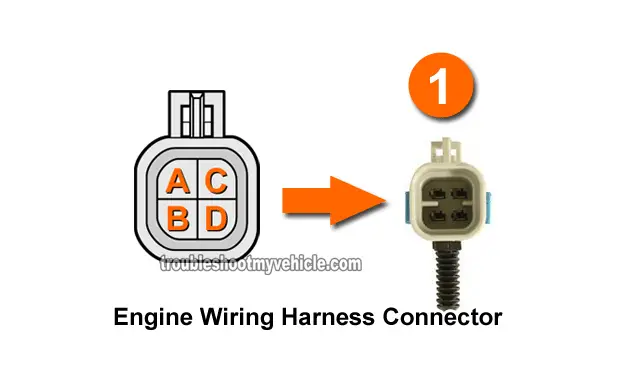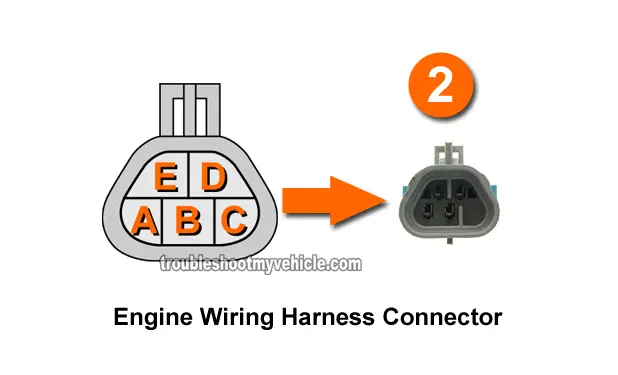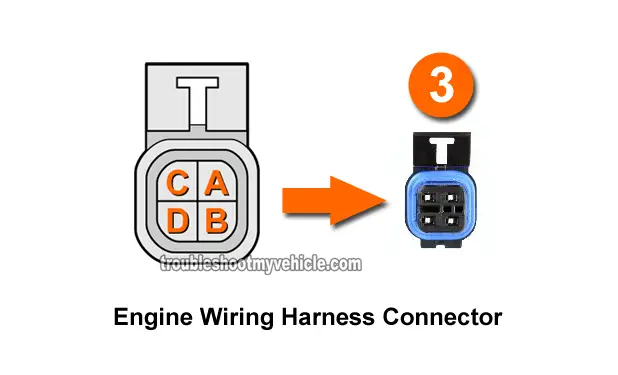
With the help from this tutorial, you be able to test the oxygen sensor to see if its heater element is really fried, and thus causing the P0135 or P0155 to light up your check engine light. In case this tutorial doesn't cover your specific vehicle, take a look at the index of tutorials here: O2 Sensor Tutorial Index.
This is a pretty simple test that you can do with a multimeter and I'll show you how to do it in a step-by-step way.
Contents of this tutorial:
- Identifying The Oxygen Sensor.
- Circuit Descriptions Of The Upstream Oxygen Sensors.
- Where To Buy The Oxygen Sensor And Save.
- TEST INFO: The Basics Of Testing The Oxygen Sensor Heater Element.
- TEST 1: Checking For 12 Volts (Pink Wire).
- TEST 2: Checking Ground (Circuit C Wire).
- TEST 3: O2 Heater Resistance Test.
Identifying The Oxygen Sensor

NOTE: Your Chevy (or GMC) pickup or SUV will have one of two types of upstream oxygen (O2) sensors for Bank 1 and Bank 2. What's the difference? You might ask. Well, its the type of connector used.
Using the photo above (at the beginning of this tutorial), if your Chevy or GMC pickup or SUV has a 4.8L or a 5.3L V8, the O2 sensor connector will look like the one labeled with number 1 or number 3.
If your GMC (or Chevy) pickup, van or SUV has the 6.0L V8 engine, then the upstream oxygen sensors for Bank 1 and Bank 2 will have the connector labeled with the number 2 in the photo.
This article covers testing all of them. Before you start testing/troubleshooting codes P0135 and/or P0155, I recommend that you take a look at the following oxygen sensor test primer:
The info in that article (Testing P0135, P0141, P0155, P0161 O2 Heater Performance Problem) answers a lot of the most common questions like:
- Symptoms Of A bad oxygen sensor heater element.
- Where are the O2 sensors located?
- What tools do I need?
- What Does the heater Inside the oxygen sensor Do?
Circuit Descriptions Of The Upstream Oxygen Sensors
As I mentioned at the beginning of this tutorial, GM uses one of three different types of upstream oxygen sensors and these can be told apart by their connectors.
In the photos I'm using in this article, I'm labeling the oxygen sensors used on the 4.8L and 5.3L V8 engines with the number 1 and number 3. The oxygen sensor type that's used on the 6.0L V8, I'm identifying it with the number 2.
This tutorial covers testing all three types and in the circuit descriptions below I've taken this into account.
| O2 Bank 1 Sensor 1 Circuits (4.8L, 5.3L) | ||
|---|---|---|
| Pin | Wire Color | Description |
| A | Tan | HO2S Low Signal |
| B | Purple w/ White stripe | HO2S High Signal |
| C | Black w/ White stripe | Heater Element Ground (Provide by PCM) |
| D | Pink | Heater Element 12 Volts (O2 sensor fuse) |
| O2 Bank 2 Sensor 1 Circuits (4.8L, 5.3L) | ||
|---|---|---|
| Pin | Wire Color | Description |
| A | Tan | HO2S Low Signal |
| B | Purple | HO2S High Signal |
| C | Light Green | Heater Element Ground (Provide by PCM) |
| D | Pink | Heater Element 12 Volts (O2 sensor fuse) |
| O2 Bank 1 Sensor 1 Circuits (6.0L) | ||
|---|---|---|
| Pin | Wire Color | Description |
| A | Tan | HO2S Low Signal |
| B | Purple w/ White stripe | HO2S High Signal |
| C | --- | Empty |
| D | Pink | Heater Element 12 Volts (O2 sensor fuse) |
| E | Black w/ White stripe | Heater Element Ground (Provided by PCM) |
| O2 Bank 2 Sensor 1 Circuits (6.0L) | ||
|---|---|---|
| Pin | Wire Color | Description |
| A | Tan | HO2S Low Signal |
| B | Purple | HO2S High Signal |
| C | --- | Empty |
| D | Pink | Heater Element 12 Volts (O2 sensor fuse) |
| E | Light Green | Heater Element Ground (Provided by PCM) |
Where To Buy The Oxygen Sensor And Save
You could buy the upstream oxygen sensor at your local auto parts store but you'll end up paying quite a bit for it (go ahead and call them and ask them how much it costs) or you could buy it online and save a few bucks.
At the bottom you'll see 3 boxes with a photo of an oxygen sensor and a price. Why 3 different oxygen sensors? Because, depending on the year and engine size of your specific GM pickup, van, or SUV, it'll have one of the 3 for the upstream oxygen sensors.
- Bosch 15150 is for the 2006-2007 4.8L and 5.3L
- Bosch 15282 is for the majority of 6.0L
- Bosch 15200 is for the 2007-2011 4.8L and 5.3L
Disclosure: As an Amazon Associate, I earn from qualifying purchases. If my tutorials help you, using these links is an easy way to support the site at no extra cost to you. Thank you!
Not sure if the O2 sensor fits your vehicle. No worries? Once you get to the site, you'll be asked for the specifics of your particular vehicle. If it doesn't fit, they'll find you the right one.
TEST INFO: The Basics Of Testing The Oxygen Sensor Heater Element
IMPORTANT: Since the oxygen sensors are connected to the exhaust pipe, they get VERY HOT with the engine running and may take a while to cool down! The test instructions, in this tutorial, call for all of the tests to be done with a cold engine and cold O2 sensors.
If the engine has been running, let it it cool down for at least 45 minutes, before attempting the tests in this tutorial or you run the risk of severe burns from the hot exhaust pipe and/or oxygen sensors.
OK, keeping the above safety precautions in mind and in a nutshell, the very first thing that has to be checked (and confirmed) is if the oxygen sensor's heater element is getting juice and Ground.
This power (juice), comes in the form of 10 to 12 Volts from an oxygen sensor fuse. Ground is provided internally by the PCM.
Here are some more specifics:
- Power is provided by the D circuit wire.
- This wire will be the Pink one, regardless of the type of O2 sensor GM has installed on your vehicle.
- Ground is provided by the C wire (4.8L, 5.3L) or the E wire (6.0L).
- This wire will be one of several colors, depending if the O2 sensor is on Bank 1 or Bank 2 and engine size. Consult the Circuit Descriptions charts above to make sure.
If any of these two is missing (power or Ground), then you have eliminated the O2 sensor as bad. Why? Well, because without power or Ground, the O2 sensor's heater element won't function and the PCM will find out (and will illuminate the check engine light with codes: P0135 and/or P0155).
Now, if both power (10 to 12 Volts DC) and Ground are present, then the next step, is to measure the resistance (with a multimeter) of the heater element inside the oxygen (O2) sensor to see if it's fried or not.
As you can see, testing DTCs P0135 and/or P0155 is not hard to do at all. OK, in the next few pages are the step-by-step testing instructions you'll need to get to the bottom of the problem.
TEST 1: Checking For 12 Volts (Pink Wire)
Before you start, I just want to remind you that the upstream oxygen (O2) sensor needs to be cold. So if the engine has been running for any amount of time, then let the engine cool down for about 45 minutes (or you run the risk of severe burns).
OK, the very first thing you need to do, is to see if the upstream oxygen sensor's heater element is getting voltage. This Voltage will be in the range of 10 to 12 Volts DC with the Key On Engine Off.
This voltage is what powers the heater element (within the O2 sensor) and if this power is missing, then the O2 sensor's heater won't work.
You can use 12 Volt automotive test light or a multimeter for this test and TEST 2 but to make sure that you're getting the right amount of Voltage, I recommend using a multimeter (don't have one or need to upgrade yours? Check out my multimeter recommendation: Buying A Digital Multimeter For Automotive Diagnostic Testing at: easyautodiagnostics.com).
OK, to get our P0135/P0155 DTC troubleshooting under way, this is what you need to do:
- Locate the upstream oxygen sensor you need to test
- Bank 1 Sensor 1 is on the 'driver' side of the engine (P0135).
- Bank 2 Sensor 1 is on the 'passenger' side of the engine (P0155).
- Jack up the vehicle and support it on jack stands (if applicable) to access the oxygen (O2) sensors.
- Never trust the jack to hold up the vehicle. Use jack stands!
- Disconnect the oxygen sensor.
- Locate the Pink wire of the engine wiring harness oxygen sensor connector.
- The letter D will be embossed on the connector.
- With the Key On Engine Off, this wire should have 10 to 12 Volts DC.
Let's take a look at your test results:
CASE 1: Your multimeter recorded 10 to 12 Volts DC. This is the normal and expected test result and tells you that the O2 sensor heater is getting power.
The next step is to make sure that the oxygen sensor's heater element is getting a good Ground on the C (4.8L, 5.3L) or E (6.0L) circuit wire. For this test, go to: TEST 2: Checking Ground (Circuit C Wire).
CASE 2: Your multimeter DID NOT record the indicated voltage- This usually means that the O2 sensor fuse, in the Engine Compartment Fuse Box is blown.
This also indicates that the other upstream oxygen sensor isn't getting power too. Check the oxygen sensor fuse and if blown, replace it and retest.









